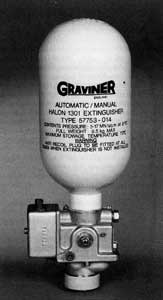| Designation: | Crew Bay |
 |
|---|---|---|
| Manufacturer: | Kidde-Graviner of Slough | |
| Product type: | Fire Fighting Equipment | |
| Name: | Fire fighting equipment |
The Kidde Graviner Crew Bay explosion, detection and suppression system was developed in the 1970s to increase AFV crew survivability in combat by detecting and suppressing fires and explosions caused by the rupturing of fuel tanks and fuel and hydraulic lines.
The Crew Bay system is able to detect and recognise an explosive fire within 2 to 3 ms of its inception and effect complete suppression in around 100 ms by the use of infra-red sensors and rapid acting high-rate discharge suppressors.
The system can be retrofitted to existing vehicles as well as being installed on new production armoured vehicles.
Kidde Graviner is part of the Kidde Aerospace and Defence Group and offers users worldwide support through its sister companies Walter Kidde Aerospace and Santa Barbara Dual Spectrum (qv later in this section), both of whom are based in the USA. In Germany the products are supported by Kidde Deugra which is a member of the Kidde International group of companies.
Crew Bay systems are fitted to a wide range of tracked and wheeled armoured vehicles including the Krauss-Maffei Wegmann Leopard 2, Vickers Defence Systems Challenger Armoured Repair and Recovery Vehicle, Vickers Defence Systems Tariq and Khaliri MBTs (Jordan), Marconi Marine, Land and Naval ; System Marksman Twin 35 mm air defence turret and ENGESA EE-11 Urutu (6 x 6) APC (Jordan).
Since production first commenced, Kidde Graviner systems are now protecting more than 4,000 production vehicles in more than 11 countries throughout the world.
The Crew Bay system uses Infra-Red (IR) detectors which do not react to the types of false alarm stimuli normally found in the battlefield environment.
The detectors are coupled to a'control unr( which automatically actuates one or more high-speed suppressors which deploy non-toxic concentrations of suppressant within the crew compartment to suppress a fuel explosion or fire before catastrophic conditions result.
The Crew Bay detector contains the IR sensors and all the logic circuitry. The sensors detect the IR radiation characteristics of a hydrocarbon explosion/ fire with the logic differentiating between the signature of a hydrocarbon flame and other non-fire stimuli.
The standard control unit is designed to accommodate four detectors and the microprocessor-based design allows manufacture of either single or dual-shot suppression systems.
As the electrically actuated valves on the suppressors require only a minimum current to operate them, enough electrical energy can be stored in the control unit to ensure that the suppressors can be activated in all vehicle conditions.
The control unit provides stabilised power and line monitoring for detection and suppression subsystems.
A number of different size suppressors can be supplied. The 3.2 kg high-speed suppressor, with electrically actuated valve, discharges its liquid contents within 80 to 100 ms. This is achieved by storing suppressant at high pressure and using alrapid action non-explosive pyrotechnic piston actuator to releasethe seal supporting mechanism, so allowing the pressure to open the valve. The suppressant then has an unobstructed path through the nozzle directly into the fire zone.
Another variant of the control unit has been designed for use with Crew Bay systems utilising up to four IR detectors and six suppressors. The control unit can be configured for up to 15 variations of detector/ suppressor combinations. Also incorporated into the control unit is built-in test equipment which utilises an eight-digit alphanumeric display.1
The control unit's BITE function offers several major features all of which are designed to provide constant monitoring of the system, thereby ensuring the crew is fully informed of any malfunction.
System fault conditions are indicated by a yellow fault lamp and an appropriate coded message on the alphanumeric display panel located on the front of the control unit.
The control unit may be switched between a number of operational modes and in normal conditions, that is with no faulty components in the system, the alphanumeric display will be blank and the faulty lamp off.
In all modes of operation it is possible using a press-to-test switch mounted on the control unit to:
(1) check the fault indicator lamp integrity
(2) test all segments of the alphanumeric display for correct operation
(3) identify the vehicle installation via the alphanumeric display for correct operation
(4) identify the mode of system operation
(5) display the appropriate code for each faulty component in the system.
In production. In service with Austria, Denmark, Finland, France, Germany, Japan, Jordan, Netherlands, Oman, Spain, Sweden, Switzerland and the UK with over 4,000 systems completed. Evaluation of new ozone friendly replacement agents continues.
|
||||||||||||||||||
 |
 |
 |
